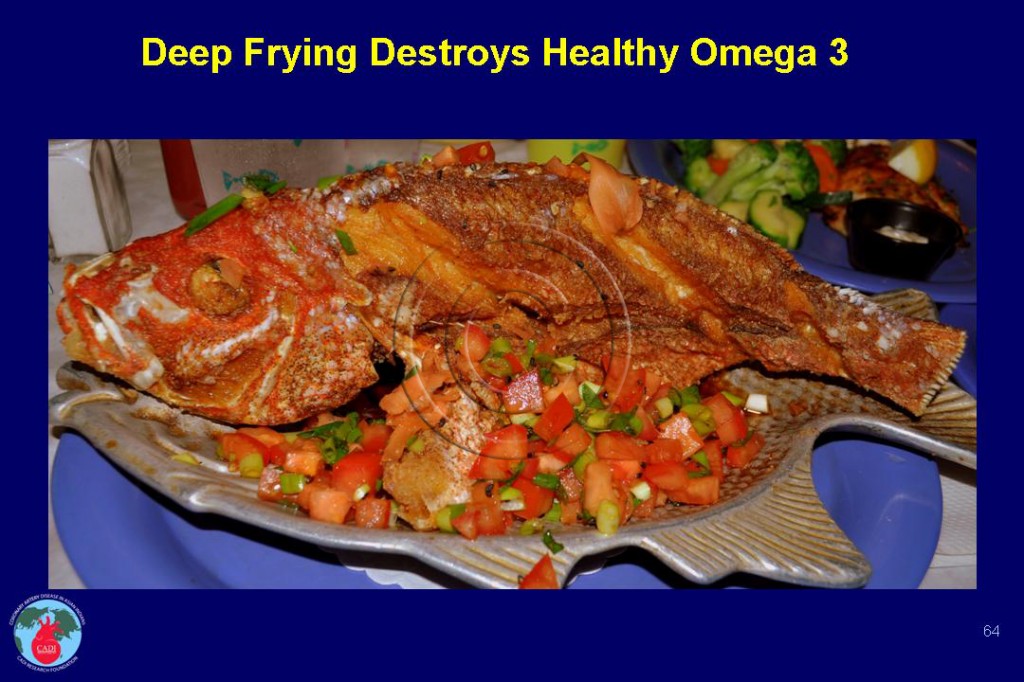Fish ─ A Tasty Way to Prevent CAD and Sudden Death
- In countries and cultures where fish consumption is high, there is a reduced risk of death from cardiovascular disease (CVD).1 Since the publication (in 1980) of pioneering studies demonstrating low rates of death from coronary artery disease (CAD) among Greenland Eskimos, fish (both finfish and shellfish) has been considered a healthy food.
- Long-term consumption of fish (2-3 servings per week) is associated with lower rates of sudden cardiac death and to a less extent, heart attacks.2 High intake of fish (900 mg/d of EPA and DHA) among the Japanese is associated with very low CAD death rates (e.g., 87% lower than comparable western populations).2 The benefits appear to be attenuated in people with heart disease who are receiving statin and other guideline adjusted treatment that lower the CVD risk substantially.3
- Compared with little or no intake, modest consumption (250-400 mg/d of EPA and DHA) lowers relative risk of sudden death by 25% to 36%. The magnitude of benefit is comparable to effects of statins on cardiovascular risk reduction.2 This can be achieved by consuming a 6 oz serving of fish per week. Incremental benefit of higher intake small suggesting a threshold of effect.2
Omega-3 Contents of Various Fish
- The fish containing the highest amount of omega-3 per 100g are mackerel (2500 mg), herring (1700 mg), and salmon (1200 mg). Other commonly used fish such as trout (500mg), halibut, tuna (400 mg), cod, and shrimp (300 mg) contain smaller amounts.
- The benefit of fish appears more strongly related to intake of cold water oily fish (e.g., salmon, herring, sardines, mackerel, cod, trout, albacore tuna), rather than lean fish (e.g., catfish, halibut).
Dangers of Frying Fish
- People should consume fish that is broiled, or baked, while avoiding heavily salted or pickled fish or fried fish. Home fried and commercially prepared fried fish meals do not lower cardiovascular risk (Figure 064).
- Commercially-prepared fried fish meals from fast food restaurants or supermarket frozen sections are often made using white-meat fish (lower in n-3 PUFAs) and prepared with partially hydrogenated oils (containing trans fats) or oils reused for multiple frying cycles (introducing oxidative/deteriorative products).
- This explains the higher cardiovascular risk seen with fried fish intake.
Cancer Risk Versus Cardiac Protection
- Cancer risks are also discouraging many people to consume fish. Cancer risk and CAD benefits were evaluated in a quantitative risk-benefit analysis, assuming regular farmed or wild salmon intake to provide 1000 mg/d of EPA and DHA over a 70-year lifetime.
- Consumption per million individuals would result in excess cancer deaths of 240 for farm raised salmon and 80 for wild salmon but would prevent 71,250 CAD deaths. For all ages, CAD benefits outweighed cancer risks by 100- to 300-fold for farmed salmon and by 300- to1000-fold for wild salmon.
Practical Recommendations
- Eat 1 to 2 servings of fish (6-12oz or 180-350g) a week as part of a heart protective diet.1 Compared with supplements, fish intake also provides potentially beneficial protein, vitamin D, and Selenium (see Fish Oil).
- The cost of consuming 250 mg/d of EPA and DHA from fish was estimated to be <$3.00/wk (for combinations of different types of salmon, tuna, anchovies, and sardines). The net actual cost would be lower because intake of fish would replace intake of other foods such as meat and dairy products.
- The benefits of modest fish consumption outweigh the risks among adults except for a few selected fish species among women of childbearing age (see Fish and Pregnancy).
- Avoidance of modest fish consumption due to confusion regarding risks and benefits could result in thousands of avoidable excess CAD deaths annually and suboptimal neurodevelopment in children.
- One can minimize concerns by choosing fish higher in n-3 PUFAs and lower in mercury or by simply consuming a variety of different seafood. Individuals with high consumption (5 or more servings/ wk) should limit intake of selected species highest in mercury.
Sources
1. Joint WHO/FAO Expert Consultation. WHO Technical Report Series 916: Diet, Nutrition and the Prevention of Chronic Diseases Geneva: World Health Organization 2003.
2. Mozaffarian D, Rimm EB. Fish intake, contaminants, and human health: evaluating the risks and the benefits. Jama. Oct 18 2006;296(15):1885-1899.
3. Chen Q, Cheng LQ, Xiao TH, et al. Effects of omega-3 Fatty Acid for sudden cardiac death prevention in patients with cardiovascular disease: a contemporary meta-analysis of randomized, controlled trials. Cardiovasc Drugs Ther. Jun 2011;25(3):259-265.


